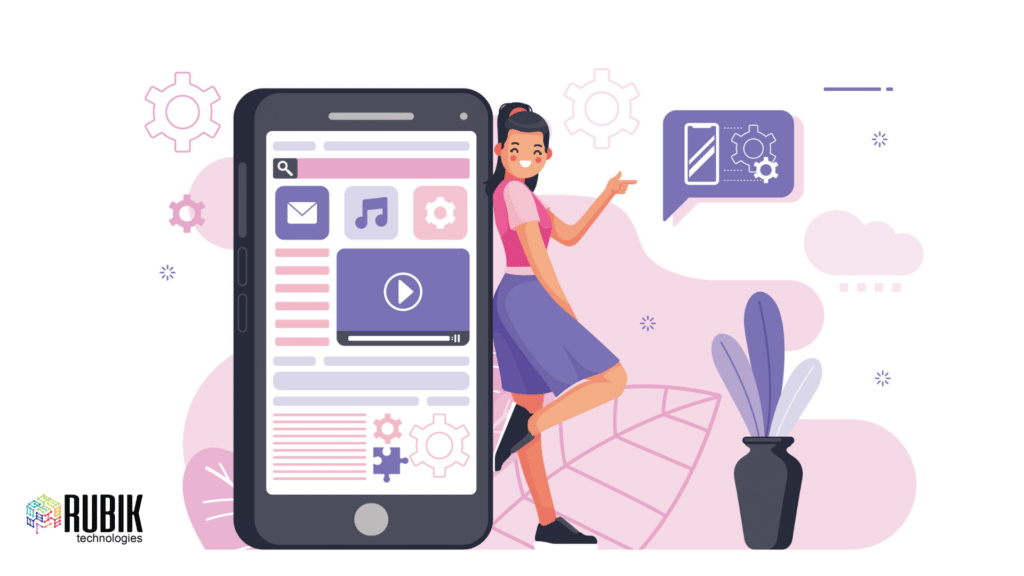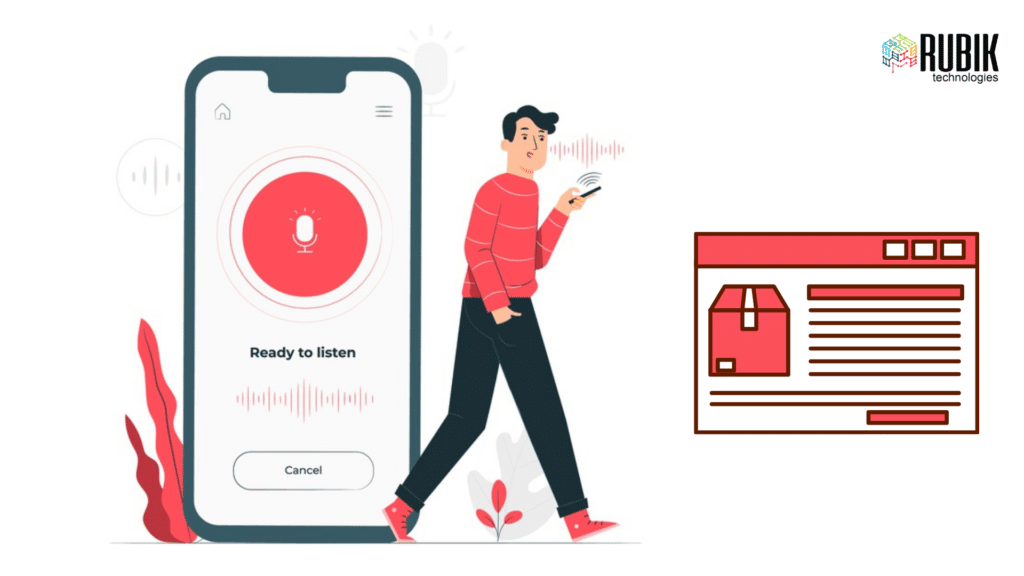It doesn’t matter how much your online store has grown. Right now, if you don’t keep up with the various ecommerce trends to increase your sales, you risk falling behind.
As we advance into the new decade, it is necessary to know these tendencies and make the most of them. That is why it is very important that ecommerce trends are analyzed and adopted quickly. Only this way you can create a strong brand voice and make it worth talking about.
- Mobile Commerce
- Voice Commerce
- Artificial Intelligence
- Visual Commerce
- Influencer Marketing
- Social Commerce
- Headless Commerce
1. Mobile Commerce
The entire digital market moves through mobile phones nowadays. Each consumer is on devices such as tablets or smartphones. This new lifestyle and digital behavior directly affect also purchasing approaches. In the following points, we explain why and how to exploit this ecommerce trend to increase your sales.

a. Accessing products in online stores is much easier.
Customers can easily discover what’s new on the market using just their devices. With Mobile Commerce, the effort and time to travel to a certain brand or solution are greatly reduced. This new type of access can put you at a disadvantage in terms of competition. It will be much easier for your customers to turn to a brand similar to yours to meet their needs if your products aren’t where they’re looking for.
b. The user experience has improved
User experience really matters in eCommerce. Today, people are familiar with the various features of smartphones and tablets. Customers already know how to navigate to the products they want by just a few clicks. Furthermore, customers share the satisfaction of acquired goods with friends or acquaintances. Many are predisposed to seeking advice in similar buyer communities. Therefore, a smooth user experience equates to better conversion rates and income.
c. A new marketing channel is created
Another benefit of mobile commerce is the creation of a new marketing channel. By creating an app dedicated to your goods, you can quickly sell your products or services to your user. In addition, it offers several features. For example, it can provide general information, search capabilities, news feeds, product prices, and so on. Another great benefit of having a mobile app for your business is that all the information you want to provide to your customers is available at your fingertips. This involves special sales and promotions. With push notifications, you can get even closer to direct interaction with your buyers. Hence, you can easily remind your consumers of your products and services when needed.
d. Track your location and send personalized notifications
Position tracking can benefit consumer assistance. For example, it can help a consumer navigate the directions or can help them discover the transport service closest to them. But how can ecommerce take advantage of this novelty?
Once a customer subscribes to your brand, you can send them push notifications based on their location, with personalized discounts, and increase your sales accordingly. This translates into a greater chance of conversions. According to Responsys research, personalized push notifications are popular with people and provide conversion rates that are twice as high as those issued by email marketers.
e. Reduces productivity costs
By reaching your customers faster with a mobile app you will certainly reduce your marketing campaign expenses. If your ecommerce app has social media integration, customers will also do their part in spreading the news. It also helps you simplify customer communications by using secure, immediate, and direct messages. In addition, the apps have reduced the workload of Customer Service departments, as it is no longer necessary to send inquiries and phone calls.
f. Higher ROI
The pay-per-click marketing technique is a huge investment for all companies that want to be at the forefront in the long run. Mobile ecommerce is a major trend in ecommerce marketing, and most retailers have understood this a long time ago. The facts show that every year all transactions made via a smartphone increase exponentially.
2. Voice Commerce

Hey Siri, set an alarm for 7:30? Alexa, call my colleague.
At home, in the office, or on the go, voice technology has become a part of our lives.
Lately, Google has added new guidelines which advise all ecommerce stores to include textual content. This means that all online retailers should start optimizing their content for voice search.
50% of all online searches will be completed using voice search.
With voice-enabled buttons, it will always be easier to capture a wider audience.
Whether looking for a nearby club, the best restaurant, hospitals, or looking for a song, we are all dependent on voice assistants. To keep up with the competition, adapting to this emerging technology is a great necessity.
Thinking from an SEO perspective, companies can use this trend to create dedicated search engine optimization strategies, using voice technology. What are the most suitable keywords or phrases for voice search? Which will bring the best results for the planned strategy?
Voice shopping is projected to reach $ 40 billion in 2022
Google’s voice search is climbing exponentially. It is critical for companies to understand this emerging trend and use it in their marketing strategy.
3. Artificial Intelligence

Artificial intelligence, or also known as AI, was invented in 1955. More than half a century later, AI has become part of almost everything we use. Be it personal gadgets, home appliances, media streaming devices, or smart cars.
Not only in the everyday life of individuals, but it has also become a valuable part of many business operations. AI is helping us understand and improve management functions and customer experience. It is one of the trending ecommerce that you absolutely must use to increase your sales.
a. Predictive analysis
The growing use of machine learning and artificial intelligence to process data has had a huge impact on augmented analytics. Also known as trend forecasting practice based on existing data. Predictive analytics is thought to be one of the biggest trends in 2020 as the number of companies using it continues to grow.
This practice has already become an essential activity for many businesses, from customer service and price optimization, recruiting, supply chain improvement, and retail sales.
By using predictive analytics, companies can become forward-thinking and proactive, preparing for behaviors and outcomes based on real data, not hypotheses.
b. Real-time marketing activities
Real-time marketing includes using instant data on what is happening right now to make marketing decisions. Instead of making plans and strategies prepared in advance, real-time marketing relies on immediate customer feedback and relevant trends.
Until the end of 2020, many marketing activities are expected to be driven by instant marketing. These activities will mainly be driven by artificial intelligence. A growing number of businesses are already using artificial intelligence to keep their customers satisfied and manage user interactions in real-time across all channels.
However, this tool is not only useful for improving the feedback and interactions of users and customers. More and more marketers have started using AI to reach new audiences across platforms as well.
c. Personalized services
Today, businesses need to provide more relevant and personalized services to attract and retain their customers. As a result, real-time information and data have become a valuable resource for understanding customer expectations and delivering the right service at the right time.
However, this is more than just segmenting users based on their interests. Valuable personalized content creates relevant and authentic user engagement at every level of the customer journey. This is where artificial intelligence provides all the much-needed help. It uses large amounts of data collected from multiple sources to define customer behavior patterns.
d. AI customer service and support
Customer experience should always be the primary focus of any business. Keeping existing customers satisfied offers a greater return than continually seeking new customers.
Artificial intelligence has enabled companies to take their customer service to a whole new level by providing better interaction and response times.
As a major trend in 2020, artificial system assistance, including customer services and other sales activities, is expected to become leaner. Some of the digital marketers predict that over 85% of all customer service communications this year will be handled without customer service representatives.
However, these solutions can have a greater impact than simply improving interactions with customer service. By using applications and programs with an artificial intelligence system, companies can also build brand loyalty or reputation, generate revenue streams, and empower almost every aspect of the business.
e. Chatbot with artificial intelligence
There are many different ways businesses can use chatbots. Although they have become common in making payments or marketing activities, customer service brings out all the benefits.
Most commonly used chatbots are built with decision tree logic, using information from large databases. It’s a great way to share basic product information or respond to simple customer inquiries. However, if a user enters a more complicated question, the chatbot may not understand specific phrases and give an adequate answer.
Until the end of 2020, chatbots are expected to become more efficient at conversations. AI-powered chatbots can remember parts of previous communications with a customer and use them to create more personalized conversations.
By offering more useful and practical communication models than human operators, AI-powered chatbots will create a better user experience and customer feedback.
f. Digital employees
One of the AI trends in 2020 is the growing number of digital workers who are transforming the traditional workspace. Software robots and AI automation have already acquired a huge role in manufacturing, retail, banking, and insurance.
Since the beginning of 2020, more and more companies are using digital robots for other office tasks as well. Digital workers are trained to do business like any other human employee, only much faster and without errors.
The use of artificial intelligence will drive business growth.
Artificial intelligence technology has already left a huge impact on several markets, changing the way businesses operate and approach their customers. Companies facing these significant changes have the choice of embracing them and becoming market leaders or staying stuck in fear of change.
4. Visual Commerce

One of the major difficulties in running an ecommerce store is having to sell your product to consumers who can not have a physical interaction with it. This is where visual commerce comes in.
In short, visual commerce is the next generation of images as it takes marketing to a whole different level. Instead of simply using product photos to market your business, visual commerce takes it one step further. It incorporates other types of images such as consumer-generated media, interactive content, engaging videos, and as mentioned earlier, augmented reality.
Visual commerce is slowly but surely becoming an integral part of ecommerce, as demonstrated by the growth of the deep learning technology behind it.
5. Influencer Marketing

With social media on the rise, public attention has shifted to the digital world. This has made the old ways of advertising become outdated. Brands are moving to digital and mostly to influencer marketing. Businesses want to grab the audience’s attention through someone who already has the public’s ear.
But who is considered an influencer? The influencer is a new professional figure who earns through the advertising he offers to brands and companies that want to make themselves known in the web world. He knows how to take advantage of the various social platforms and is able to “influence” a particular community as much as possible.
In practice, a good influencer must have a certain number of followers, choose brands that are close to his image, and know how to write about these brands. His best ability is to know how to leverage certain emotions and thus convince his followers of the benefits of a certain product of a certain brand.
Consumers seek product recommendations from influencers almost as often as they do from friends.
Influencers commonly categorize themselves among:
- Celebrities (+1 million followers)
- Macro influencer (+500 thousand followers)
- Middle influencer (+100 thousand followers)
- Micro influencer (up to 100 thousand followers)
How does the collaboration between brand and influencer work?
The various brands can make agreements to exchange products or services for free, economic compensation, or even a combination of the two.
The most common deals for micro influencers include products such as clothing, accessories, edibles, travel, or hotel stays. But this is not necessarily restrictive. The types of businesses that require the services of influencers can also be such as fitness centers & spas, banks, baby products, and much more.
Influencer marketing is especially popular on Instagram, already a $1.7 billion industry.
At this moment all eyes are turned to Instagram. Nearly four in five brands (79%) use Instagram for influencer campaigns, compared to Facebook (46%), YouTube (36%), Twitter (24%), and LinkedIn (12%).
Below we present the most clicked and paid influencers in the world for 2020.
- YouTube Influencer Dude Perfect
- Facebook Influencer Shakira
- Twitter Influencer Jason Keath
- LinkedIn Influencer Jeff Weiner
- Instagram influencer Cristiano Ronald
- Instagram Influencer Ariana Grande
- Instagram influencer Dwayne “The Rock” Johnson
- Micro influencer Alastair Humphreys
The selection of the right influencer for your products and services must take place after a study of the type of person, but above all after an analysis of his audience, engagement rate, cost/benefit ratio, and his ability to make himself credible and be able to sell.
To measure the success of the campaign started, you can rely on statistical data, and the good news is that you can check them directly from your site. These might be the traffic on your ecommerce, impressions, the number of products sold or services offered through a specific discount code.
On the other hand, a factor not to be underestimated is the increase in followers on your account, and also the engagement rate. Finally, the CPM is the Cost per Mille, which is a commonly used indicator in the advertising sector that shows you how much it costs to show advertising for 1000 views of the same.
6. Social Commerce

Social commerce is the ability to purchase a product from a third party company within the native social media experience. For example, you can find some products on Facebook and after that, make the purchase on Facebook itself, instead of going to the company’s website. Or you can inquire about a product from a tweet and make the purchase on Twitter itself.
It is a growing and evolving field of online marketing that works in conjunction with social media and the growth of online shopping. Fashion and shopping blogs use social commerce and media to entice shoppers to purchase related items online. For example, many popular fashion blogs have Instagram accounts that allow followers to like, share, and comment on the product on offer. The marked item often links directly to the shopping cart or checkout in the store.
Below we tell you about three social media platforms that own the social commerce space: Facebook, Instagram, and Pinterest.
Businesses can create an entire “Buy Now” store. What’s more, Facebook Messenger is used by companies to interact with consumers and thus offer customer support before, during, and after the sale.
With a Facebook shop, you can:
- Upload products and product information;
- Curate and customize the product catalog;
- Sell directly from your page;
- Manage orders;
- Publish an ad on Facebook to promote products;
About 70% of shoppers turn to Instagram to discover products. It is also for this reason that Instagram has introduced Instagram Shopping. A feature that allows users to click on images and stories to view the products featured on it.
The purchasable pins were released in June 2015. At the time, there were 30 million on the site, but just three months later Pinterest reported that the number had doubled to 60 million. According to Shopify, the average sales order value from Pinterest is $50, which is higher than any other social media platform.
The peculiarity of Pinterest is that a small part of the site’s content is original. According to one source, 80% of Pinterest content is a repin. This is a big advantage for original content creators.
But how can we know if Social Commerce works for our business? In fact, it offers a myriad of business benefits for the brand. From increased sales, increased traffic to increased customer engagement and website traffic.
When customers are happy with your business, social media makes it easy to share and recommend your brand. By its very nature, social media is a place where content goes viral. These channels, therefore, play a very important role in spreading the word about your brand and products.
5 benefits of social commerce
1. Wider audience
Thousands of new users join social media sites around the world. Millions are already active on it. Facebook alone has over a billion active users every month, and many new users join every hour. One of the most important considerations for any business is how to reach and sell to their target customer audience. For companies using social commerce, their followers base is constantly growing.
2. Better search engine rankings
Engagement on social media leads to much more than just direct transactions. Social media commerce has been shown to actually increase traffic to your website. Eventually, this will affect your ranking in search engine results. Sharing links to your website content via social media is an excellent way to drive traffic from social media users.
3. Engagement and traffic
One of the most significant benefits of social commerce is the engagement and reach that businesses can achieve every time they share content. By posting and making yourself heard regularly in a follower’s update feed, you are giving your brand a powerful opportunity. People who have regular contact with a company are more likely to recommend that company.
4. Customer loyalty
By using social commerce for your business, you aim to sell and promote your products and services. In the meantime, you also aim to build good relationships with the people. Using this opportunity to interact with potential customers, a company can build and maintain relationships that build trust and loyalty. This in turn creates customers who are satisfied with your service, who are likely to remain customers who make repeat purchases.
5. Business metrics
Social media commerce makes it easy to measure and evaluate performance. Facebook pages, Instagram business accounts, and Twitter tweets have built-in metrics for impressions, interactions, and reach. Additionally, most social media posts allow for the measurement of traffic to your website by counting website clicks. Other basic metrics for determining a positive ROI could include the total number of fans or followers, likes, and the overall number of interactions.
7. Headless Commerce

Headless Commerce offers a cutting-edge ecommerce approach to website design and development. Headless Commerce happens when you disconnect a website’s front-end CMS, also known as a website’s “head”, from the back-end of ecommerce. In a “Headless” environment, the two worlds are linked together using APIs.
In ecommerce, Headless Commerce allows marketers to adapt the content of a page without the traditional constraints of CMS. This way, they can quickly update the copy to keep focusing on their main needs: marketing!
Amazon is a good example for us to really understand the value of a Headless Commerce platform and how this platform can help retailers. According to a Salmon study, 60% of consumers want a service similar to Amazon Prime. A service impossible to offer with traditional ecommerce solutions.
Why is Headless Commerce a trending ecommerce that will help increase your sales?
1. Omnichannel
A headless content management system will help you get your content seen everywhere. For an ecommerce brand, this means presenting your products, product videos, or blog posts to any channel that has emerged or will emerge.
2. Competitiveness
A headless trading platform allows you to launch quick updates without impacting your backend system. You can make changes to your front-end easily and quickly. This way you are always sure that it will coincide with the speed of consumer technology.
3. Fast Marketing
A Headless Commerce system can support new technology as soon as it arises. This is perfect for designing new customer experiences. The marketing team will be enabled to implement multiple sites across different brands, divisions, and portfolios.
4. Personal and Consistent Customer Experience
Customer needs should always receive a consistent customer experience across all devices and channels. Consumers want to buy from ecommerce brands that understand their needs across all channels. The backend uses their data to power the personalization engines on CMS, mobile apps, and social channels.
5. Perfect Integrations
A Headless Commerce solution must have an API, which makes it easy to integrate and communicate with other platforms. You can add your brand to any new device; tablet, pc, or smartphone. This will expand your opportunities and reach more customers at the same time. Plus, your trading platform will be integrated on a new device in just a few hours.
6. Improved Conversion Optimization
A Headless Commerce allows you to run continuous tests. This certainly involves optimization cycles that will help you better understand your customer. This will improve your learning speed. For example, you may be experimenting with a different backend search solution while running the same front end search.
We do not have absolute certainty of how people and consumers, in general, will move in the online world in the future and especially in the online shopping sector. On the other hand, we are aware that at the moment we are experiencing a strong connection to the digital. The current situation has forced us to learn new skills by relying on online courses only. We are keeping our body fit with personal trainers from the screen and even entertaining ourselves with platforms such as Netflix.
The various data that Google searches offer, inform us that in 2020 there was a 100% increase in searches for how to break down boredom compared to last year. This data helps us understand how the user is moving and what he is looking for at this moment. Adapting to its needs and adopting the insights we share, you can use these ecommerce trends to increase your sales. By understanding the two needs and getting the right information about general online searches, it is easier to improve the type of offer to our customers.








